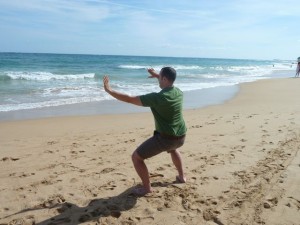
Last month, we discussed the sense of progress you can sometimes struggle with in your practice. At the time, I mentioned that I've been working up to a two-hour standing session, which is a very structured practice goal.
Today, I wanted to report back about what I've been experiencing in standing qigong and show you how to shift your sense of the time that passes when you stand. The structure of adding one minute to the length of the stand each day is seems like it should make for a very linear sense of time when you practice. So far, though, that's not what's happening at all.
Linear Time and Work
When you set your sights on a single two-hour qigong stand, it might sound blissful and energizing or it might sound grueling, especially when you think about inching closer to the goal by adding only one minute a day.
And when the qigong practice is not going well, it is grueling. When the posture is "off," you experience:
- isolated muscle pulls
- joint discomfort
- tension, pain, and contraction
- energetic blockages
Your reaction is often to fight these sensations directly, trying to stretch a contracted muscles or shift away from a compressed joint. When you're fighting a thousand little battles all over your body, time ticks by one second at a time, becoming slow, linear, painful work.
Cycles of Flow
When your qigong posture is "on," it's completely different. Everything feels continuous and flowing, but at the same time still without becoming stagnant. For example, you might experience your back expanding outward for several minutes or your front releasing inward or your legs sinking downward. You haven't moved, but the expansive/releasing/sinking quality goes on and on and on.
And this is where time shifts.
The same way that you feel movement and flow without actually moving, time passes without a sense of the minutes ticking by. In this "on state," the posture feels easy and comfortable. Time doesn't feel as pressing because you don't feel like you're working on the posture. You lose a sense of sustained work, endurance, and duration.
Unfortunately, this state doesn't last.
You can sustain it for a while, but it falls apart. I used to find that very frustrating, until I discovered that it wasn't all or nothing for keeping the "on state." The posture comes together and falls apart in cycles. In longer standing qigong sessions you will go through several cycles of flow.
Here is how you can find these cycles:
- Find your "natural stand" time: get a clock, close your eyes and just stand for as long as it feels easy and comfortable.
- Repeat step 1 three times, seeing if the time for your natural stand is consistent (or repeat into you establish and natural baseline).
- The next time you practice, add 5 minutes to your natural stand time.
- Notice what happens to your body, mind, and energy when you go into the extra time, past your natural stand time.
- Keep adding time into you find your second natural phase.
- Over time, work up to standing for 2 or 3 natural cycles.
When your standing posture comes together, the body will be relaxed and integrated, your energy will be flowing, the mind will be expanded and enveloping, and your mood will be calm. As you shift into an "off" phase, you may notice that your body gets stiff and isolated, your energy feels stuck, your mind starts to contract, and you feel impatient. The more you can tune into these sensations at all levels, the more you will be able to recognize the natural cycles of flow in your practice and the "time" you stand for will shift to more circular and integrated.

Share this post
Twitter
Google+
Facebook
Reddit
LinkedIn
StumbleUpon
Pinterest
Email